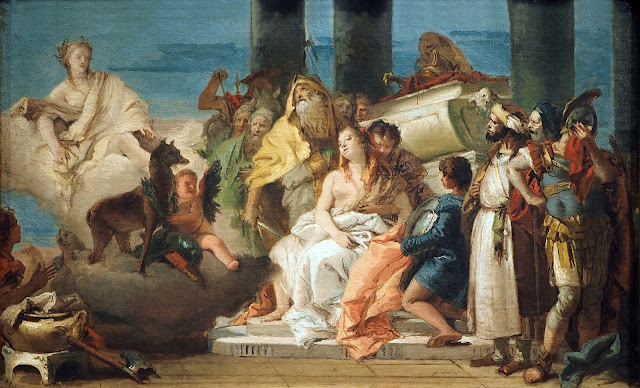 |
| Giambattista Tiepolo Armida encounters the sleeping Rinaldo (detail) (scene from Gerusalemme Liberata) ca. 1742-45 oil on canvas Art Institute of Chicago |
 |
| Giambattista Tiepolo Armida encounters the sleeping Rinaldo (detail) (scene from Gerusalemme Liberata) ca. 1742-45 oil on canvas Art Institute of Chicago |
 |
| Giambattista Tiepolo Armida encounters the sleeping Rinaldo, with Venus presiding (scene from Gerusalemme Liberata) ca. 1742-45 oil on canvas Art Institute of Chicago |
 |
| Giambattista Tiepolo Rinaldo and Armida in her Garden (scene from Gerusalemme Liberata) ca. 1742-45 oil on canvas Art Institute of Chicago |
 |
| Giambattista Tiepolo Rinaldo and Armida in her Garden (detail) (scene from Gerusalemme Liberata) ca. 1742-45 oil on canvas Art Institute of Chicago |
 |
| Giambattista Tiepolo Rinaldo and Armida in her Garden (detail) (scene from Gerusalemme Liberata) ca. 1742-45 oil on canvas Art Institute of Chicago |
 |
| Giambattista Tiepolo Rinaldo and the Magus of Ascalon (scene from Gerusalemme Liberata) ca. 1742-45 oil on canvas Art Institute of Chicago |
 |
| Giambattista Tiepolo Rinaldo and the Magus of Ascalon (detail) (scene from Gerusalemme Liberata) ca. 1742-45 oil on canvas Art Institute of Chicago |
 |
| Giambattista Tiepolo Sacrifice of Iphigenia ca. 1747-50 oil on canvas Kunsthalle, Hamburg |
 |
| Giambattista Tiepolo Sacrifice of Iphigenia ca. 1750 oil on canvas Speed Art Museum, Louisville, Kentucky |
 |
| Giambattista Tiepolo Flight into Egypt in a Boat guided by Angels ca. 1765-70 oil on canvas Museu Nacional de Arte Antiga, Lisbon |
 |
| Giambattista Tiepolo Martyrdom of St Sebastian 1739 oil on canvas Cleveland Museum of Art, Ohio |
 |
| Giambattista Tiepolo Miracle of the Bronze Serpent (detail) 1731-32 oil on canvas Gallerie dell'Accademia, Venice |
"A finished picture by Tiepolo, an altarpiece or fresco, exhibits the process of its making, as do the pictures of many painters. But it does not do so by displaying underdrawing, or corrections, or even very assertive brush strokes. Rather, an earlier process has been internalized into the finished forms of the figures and other objects – but particularly the human figures – that he represents: their forms declare that process. Again, this must be so of the pictures of many painters. But Tiepolo's manner is unusual for the peculiar clarity and snap with which it exhibits the muscular differentiation underlying itself. His figures act out his creative process in the shape they have taken; and this displaced performance of self feeds an idiosyncratic vitality into his depiction of the human predicament . . ."
"One positive result of having been, relatively speaking, out of public view, is that Tiepolo's painting has remained exceptionally free of the interference of later art as well as of the tradition of critical writing. It is hard, perhaps impossible even, not to see canonical works in the tradition through the eyes of the artists that came after: we see Cézanne, for example, through cubist eyes. Tradition keeps earlier art alive, but in doing so, transforms it. This does not obtain with Tiepolo. His painting retains its original freshness. And rarely has the pictorial enterprise been so single-mindedly pursued."
– from Tiepolo and the Pictorial Intelligence, Svetlana Alpers and Michael Baxandall (Yale University Press, 1994)

